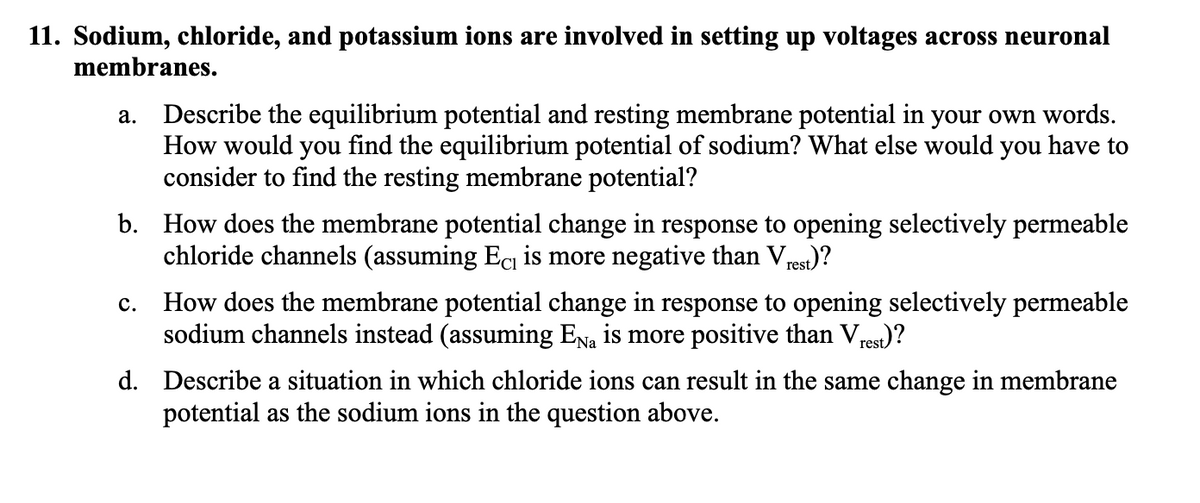11. Sodium, chloride, and potassium ions are involved in setting up voltages across neuronal membranes. a. Describe the equilibrium potential and resting membrane potential in your own words. How would you find the equilibrium potential of sodium? What else would you have to consider to find the resting membrane potential? b. How does the membrane potential change in response to opening selectively permeable chloride channels (assuming Ec is more negative than Vrest)? C. How does the membrane potential change in response to opening selectively permeable sodium channels instead (assuming Ena is more positive than Vrest)? d. Describe a situation in which chloride ions can result in the same change in membrane potential as the sodium ions in the question above.
11. Sodium, chloride, and potassium ions are involved in setting up voltages across neuronal membranes. a. Describe the equilibrium potential and resting membrane potential in your own words. How would you find the equilibrium potential of sodium? What else would you have to consider to find the resting membrane potential? b. How does the membrane potential change in response to opening selectively permeable chloride channels (assuming Ec is more negative than Vrest)? C. How does the membrane potential change in response to opening selectively permeable sodium channels instead (assuming Ena is more positive than Vrest)? d. Describe a situation in which chloride ions can result in the same change in membrane potential as the sodium ions in the question above.
Biology: The Dynamic Science (MindTap Course List)
4th Edition
ISBN:9781305389892
Author:Peter J. Russell, Paul E. Hertz, Beverly McMillan
Publisher:Peter J. Russell, Paul E. Hertz, Beverly McMillan
Chapter39: Information Flow And The Neuron
Section: Chapter Questions
Problem 5TYK: The major role of the Na+/K+ pump is to: a. cause a rapid firing of the action potential so the...
Related questions
Question

Transcribed Image Text:11. Sodium, chloride, and potassium ions are involved in setting up voltages across neuronal
membranes.
a. Describe the equilibrium potential and resting membrane potential in your own words.
How would you find the equilibrium potential of sodium? What else would you have to
consider to find the resting membrane potential?
b. How does the membrane potential change in response to opening selectively permeable
chloride channels (assuming Ec is more negative than Vrest)?
C. How does the membrane potential change in response to opening selectively permeable
sodium channels instead (assuming Ena is more positive than Vrest)?
d. Describe a situation in which chloride ions can result in the same change in membrane
potential as the sodium ions in the question above.
Expert Solution
This question has been solved!
Explore an expertly crafted, step-by-step solution for a thorough understanding of key concepts.
This is a popular solution!
Trending now
This is a popular solution!
Step by step
Solved in 3 steps

Knowledge Booster
Learn more about
Need a deep-dive on the concept behind this application? Look no further. Learn more about this topic, biology and related others by exploring similar questions and additional content below.Recommended textbooks for you

Biology: The Dynamic Science (MindTap Course List)
Biology
ISBN:
9781305389892
Author:
Peter J. Russell, Paul E. Hertz, Beverly McMillan
Publisher:
Cengage Learning

Anatomy & Physiology
Biology
ISBN:
9781938168130
Author:
Kelly A. Young, James A. Wise, Peter DeSaix, Dean H. Kruse, Brandon Poe, Eddie Johnson, Jody E. Johnson, Oksana Korol, J. Gordon Betts, Mark Womble
Publisher:
OpenStax College

Biology 2e
Biology
ISBN:
9781947172517
Author:
Matthew Douglas, Jung Choi, Mary Ann Clark
Publisher:
OpenStax

Biology: The Dynamic Science (MindTap Course List)
Biology
ISBN:
9781305389892
Author:
Peter J. Russell, Paul E. Hertz, Beverly McMillan
Publisher:
Cengage Learning

Anatomy & Physiology
Biology
ISBN:
9781938168130
Author:
Kelly A. Young, James A. Wise, Peter DeSaix, Dean H. Kruse, Brandon Poe, Eddie Johnson, Jody E. Johnson, Oksana Korol, J. Gordon Betts, Mark Womble
Publisher:
OpenStax College

Biology 2e
Biology
ISBN:
9781947172517
Author:
Matthew Douglas, Jung Choi, Mary Ann Clark
Publisher:
OpenStax

Cardiopulmonary Anatomy & Physiology
Biology
ISBN:
9781337794909
Author:
Des Jardins, Terry.
Publisher:
Cengage Learning,